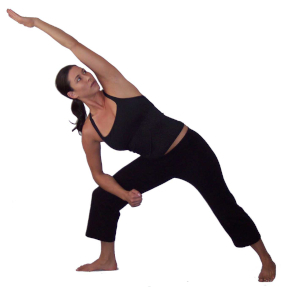
Standing poses are an important part of any well rounded yoga practice. They offer a lot of benefits including increased flexibility and strength. When performing standing poses, it is important to correctly activate the legs and align the joints in order to maximize the benefits and keep you safe.
To ensure knee safety in standing yoga poses, the most important action is to maintain proper alignment. I have never heard another instructor talk about this, yet injuring your knee, even if you have a healthy strong body, is incredibly easy if you don’t pay attention to joint alignment. And, good knee alignment will also help keep your ankles and hips safe, especially if you have some weakness or injury in either of those areas.
The poses where alignment is most important are standing poses, especially when one or both knees are bent. When doing any bent knee position in any activity, the proper alignment is to keep your knee over the ankle, and pointing the same direction as the toes. A great pose to explain this with is Warrior Pose, also called Warrior 2 or Virabhadrasana.
Warrior Pose is a wide leg standing pose with the front knee bent. There are two directions the knee can go out of alignment, when it goes too far forward past the toe, and if it shifts forward or back; any direction it can go where it isn’t over the ankle. So, bending the knee too far takes it out of alignment to a place of potential injury, and letting it flex forward so it isn’t over the ankle can also cause an injury. It can also flex too far back, but that isn’t very common, even for beginners.
Going too deep in the pose without a wide enough of a stance takes the knee past the ankle. It is actually safe to go a little deeper than that, but once the knee moves past the toes the chance for injury is great. The best thing to do if you want to go deeper in any pose is to widen the stance.
As mentioned, the other direction the knee can go out of alignment is if it swings too far forward or back, too far forward being the most common in this case. This often happens when the back leg is appropriately strengthened, which is ideal in most standing poses. The strong leg rotates the thigh back which rotates the hips to that side. The front leg is then pulled forward of the ankle.
The adjustment is to use the front leg muscles to pull the knee back in order to maintain proper alignment. This creates a nice stretch in the front inner hip/groin area, one of the benefits of Warrior Pose. The point here is maintaining proper knee alignment and knee safety.
Many of the standing rotated poses are even more likely to pull your knee forward out of alignment which puts stress on it. This is something that everyone needs to recognize to avoid knee injury. For many people with joint problems this is the most important thing to pay attention to in bent knee poses.
Those are the two directions the knee can go out of alignment. Let’s look at another pose that isn’t quite as intense on the knee; Lunge Pose.
In lunge with the back leg up you also need to keep your knee over the ankle though it isn’t always quite as important as in standing poses.
One of my favorite ways to work knee down lunge is to shift forward slightly by bending the front knee. This pulls the back leg so the back knee slightly rolls forward over the skin. This gives a great stretch in the back groin and the front of the back thigh. But, you could end up shifting so far forward that your front knee goes past the toes. However, since the back knee is down, there isn’t much weight on the front leg and knee, so there isn’t really enough pressure that could injure the knee (unless there’s an existing problem).
Proper knee alignment is much more important when doing lunge and lunge type poses with the back knee lifted. As mentioned earlier, rotated poses can cause more of an issue because of lateral movement of the knee.
A final pose we’ll look at is the wide squat. When done with a very wide stance it is almost impossible to maintain perfect alignment. Not only will the knees be more forward of the ankles, but the knees will likely be pointing in a different direction than the toes.
The way to protect your knees in this pose is to really work the knees back so they stay as close to over the ankles as possible. And, you need to turn your feet out to insure the knees and toes point in the same direction. For most people this means a 45 degree turnout for the feet. Ideally, you would only go as deep as you can without shifting the knees forward and out of alignment.
Many people really like to go deep in this pose though, often to the point where the alignment is really off. While I encourage not doing this, I do understand that some people like the work a deeper pose brings. For them, I encourage paying attention to the best teacher there is; pain. Remember that pain equals no gain!
Stay safe in your yoga practice by keeping correct knee alignment, you won’t regret it. This practice will also keep you safe in all other activities as well. And, if you already have an injury then you now know how to help prevent a re-injury.


